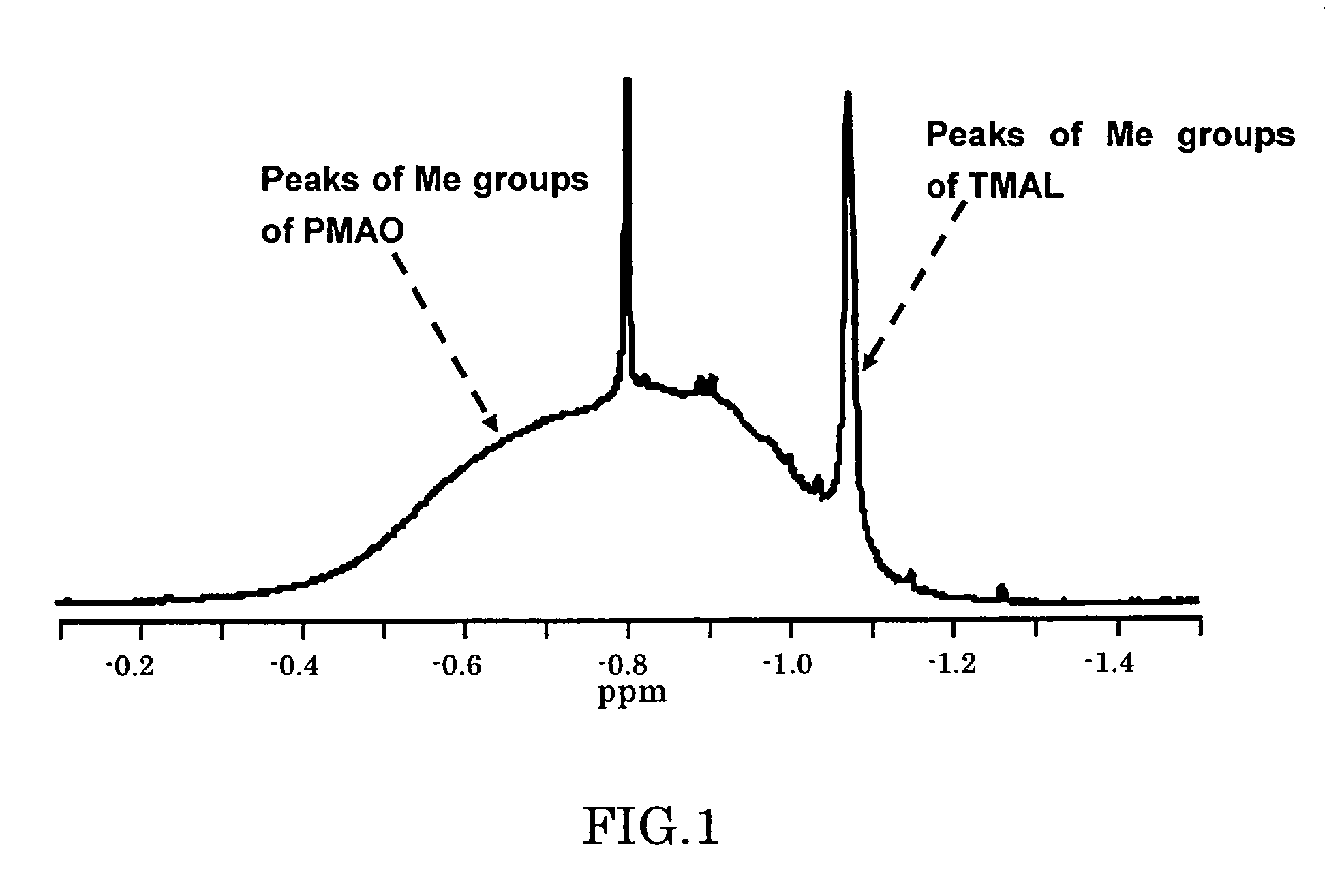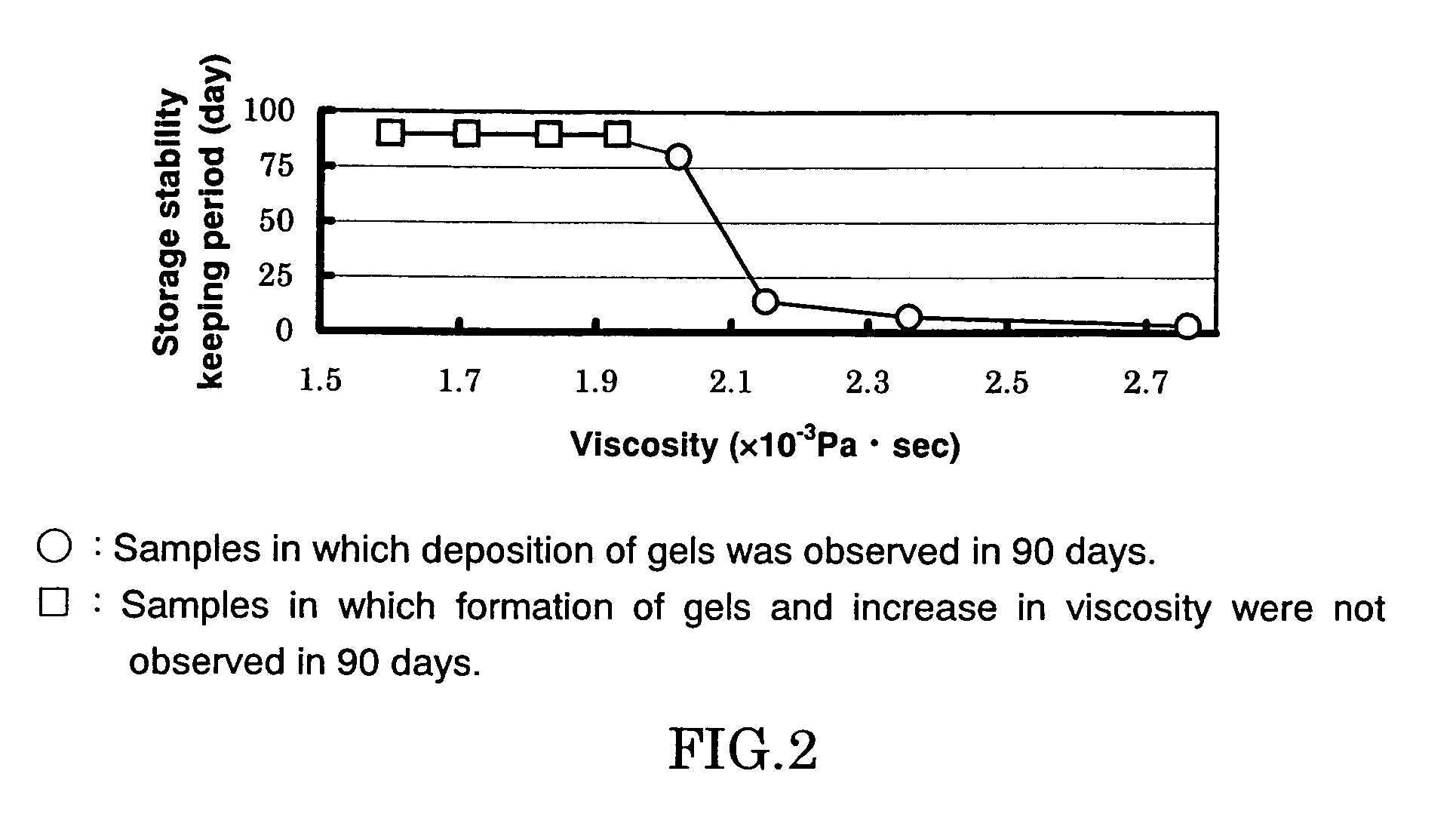Polymethylaluminoxane preparation, method of producing the same, polymerization catalyst, and polymerization method of olefins
a technology of polymethylaluminoxane and polymethylaluminoxane, which is applied in the direction of catalyst activation/preparation, chemical/physical processes, and group 3/13 element organic compounds, etc. it can solve the problems of long reaction time, reduced yield, and reduced reaction yield based on aluminum, etc., to achieve low solution viscosity, easy to handle, and maintain stability for a long time
- Summary
- Abstract
- Description
- Claims
- Application Information
AI Technical Summary
Benefits of technology
Problems solved by technology
Method used
Image
Examples
example 1
(1) Synthesis of Polymethylaluminoxane Preparation
[0099]To a separable flask equipped with a stirrer having an inner volume of 2 L, 240.8 g (3.34 mol) of trimethylaluminum (hereinafter, abbreviated as TMAL) and 160.2 g of toluene were introduced. To this solution, 500.1 g of benzoic acid solution in toluene (benzoic acid: 0.49 mol) was slowly added at 26° C. Into this reaction mixture, 89.9 g (0.74 mol) of benzoic acid in powder form was added at 26° C., and then allowed to mature under heating at 50° C. for one hour. At this time, the molar ratio between TMAL and oxygen atoms of benzoic acid was 1.36:1. The reaction mixture was heated at 80° C. for 2 hours, and then heated at 80° C. for additional 6.5 hours, to obtain a polymethylaluminoxane preparation solution in toluene. The resultant solution was transparent liquid not including gels. An Al analysis conducted after collection of the reaction liquid showed a quantitative reaction yield based on the Al atoms. Al concentration of ...
example 2
(1) Synthesis of Polymethylaluminoxane Preparation
[0102]A polymethylaluminoxane preparation was synthesized in the same manner as described in Example 1 except that the amount of benzoic acid added in powder form in Example 1 was changed so that the molar ratio between TMAL and oxygen atoms of benzoic acid was 1.30:1. The resultant solution was transparent liquid not including gels. An Al analysis conducted after collection of the reaction liquid showed a quantitative reaction yield based on the Al atoms. Al concentration of the obtained reaction mixture was 9.4 wt %. Me(TMAL) amount of the resultant polymethylaluminoxane preparation determined by the 1H-NMR was 18.3 mol %. Solution viscosity of the polymethylaluminoxane preparation measured by using an Ubbelohde viscometer was 1.93×10−3 Pa·sec.
[0103]The obtained polymethylaluminoxane preparation was subjected to a storage stability test at 25° C. for 90 days, and formation of gels and increase in viscosity were not observed.
(2) Eva...
example 3
(1) Synthesis of Polymethylaluminoxane Preparation
[0105]A polymethylaluminoxane preparation was synthesized in the same manner as described in Example 1 except that the amount of benzoic acid added in powder form in Example 1 was changed so that the molar ratio between TMAL and oxygen atoms of benzoic acid was 1.40:1. The resultant solution was transparent liquid not including gels. An Al analysis conducted after collection of the reaction liquid showed a quantitative reaction yield based on the Al atoms. Al concentration of the obtained reaction mixture was 9.4 wt %. Me(TMAL) amount of the resultant polymethylaluminoxane preparation determined by the 1H-NMR was 22.6 mol %. Solution viscosity of the polymethylaluminoxane preparation measured by using an Ubbelohde viscometer was 1.60×10−3 Pa·sec.
[0106]The obtained polymethylaluminoxane preparation was subjected to a storage stability test at 25° C. for 90 days, and formation of gels and increase in viscosity were not observed.
(2) Eva...
PUM
| Property | Measurement | Unit |
|---|---|---|
| viscosity | aaaaa | aaaaa |
| viscosity | aaaaa | aaaaa |
| viscosity | aaaaa | aaaaa |
Abstract
Description
Claims
Application Information
 Login to View More
Login to View More - R&D
- Intellectual Property
- Life Sciences
- Materials
- Tech Scout
- Unparalleled Data Quality
- Higher Quality Content
- 60% Fewer Hallucinations
Browse by: Latest US Patents, China's latest patents, Technical Efficacy Thesaurus, Application Domain, Technology Topic, Popular Technical Reports.
© 2025 PatSnap. All rights reserved.Legal|Privacy policy|Modern Slavery Act Transparency Statement|Sitemap|About US| Contact US: help@patsnap.com


